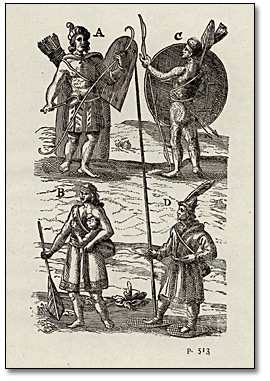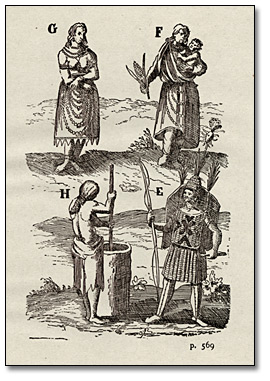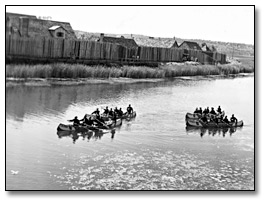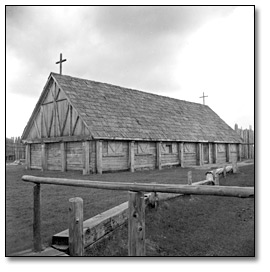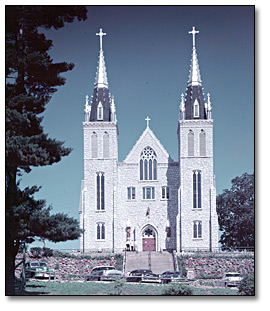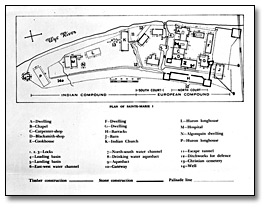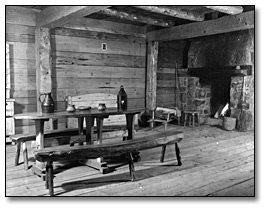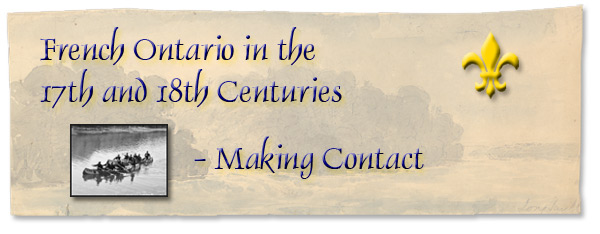
Table of Contents
Making Contact | Transitions | Resources and Trade
People, Places and Times | War and Defence | To Learn More
|
North America had been inhabited for thousands of years when the first Europeans arrived. Contact between the First Nations and the newcomers would have a profound impact on both cultures. The fur trade fuelled trans-atlantic trade, and the Europeans learned techniques that helped them adapt to the new land. To the first inhabitants, contact brought goods previously unknown, but European diseases and the impact of ever-expanding white settlement dislocated and in some cases dispersed their societies. European attempts at converting First Nations to Christianity also changed their world. For Europeans and First Nations alike, the mutual encounter meant meeting with the unknown. How they viewed each other greatly influenced their relations. |
||
|
|
|
|
|
The Europeans’ perception of First Nations was conditioned by their belief in the superiority of their culture and faith. Often, Aboriginals were depicted as uncivilized “Savages” and their religions as “devil-worshipping.” More positive views, such as those of the French Jesuit Charlevoix in the early 18th century, sometimes emphasized the “natural” qualities of Aboriginals, in contrast to European “civilization” with its moral failings and quest for money. |
||
|
||
|
|
||
|
Converting “pagans” to the Christian faith was, with trade, the most important motive for French expansion in the interior. Missionaries attempted not only to convert the populations they encountered, but also to replace local cultures with French “civilization”. One of the first historians of New France, Gabriel Sagard, wrote in 1636: |
||
|
||
|
One of the most important missions was to the Huron (Wendat) of the Georgian Bay area, an agricultural nation with strong ties to the French. |
||
|
|
||
|
Recollets first came to Huronia in 1615, followed by the Jesuits in 1626. By 1648, the Jesuits had 25 missionaries living among the Huron people. Sainte-Marie Among the Hurons, a small settlement built in 1639 in the heart of Huron country, served as a base for the missionaries, and was home to a small group of donnés, hired servants and soldiers. Sainte-Marie thus became the first French settlement in the interior. It was comprised of a fortified European compound surrounded by a walled village servicing the needs of Huron converts to Christianity. The photograph to the right shows canoes on the Wye River passing by a modern-day reconstruction of Sainte-Marie Among the Hurons. |
| |
|
||
|
|
Despite efforts by the Jesuits to integrate Christian faith and native culture, their mission had mixed results, and only a minority – mostly the young and elderly – became Christians. The Huron were divided between traditionalists hostile to the Jesuits and a minority “Christian party” supported by the French. Both the Huron nation and the Jesuit mission were destroyed by the Iroquois between 1648 and 1650. A few hundred Huron took permanent refuge near Quebec and smaller groups scattered throughout the Great Lakes area, but most of the population was either killed or assimilated within the Iroquois Confederacy. |
|
|
The Jesuits abandoned Sainte-Marie, then a second mission (Sainte-Marie II) built on an island in Georgian Bay. Eight Jesuits and donnés, killed between 1642 and 1649, were later canonized by the Catholic Church as the “Canadian Martyrs”. The church to the right was built in 1926 in Midland, near Sainte-Marie among the Hurons to honour the martyrs. Other missionary efforts were later undertaken, primarily near the most important trading posts. They met with mixed results and none had the same importance or impact as the Huronia mission. |
|
|
|
|
||
|
The Ontario government rebuilt Sainte Marie Among-the-Hurons during the 1960s as an interpretative tourist attraction. The photographs below show the reconstructed site. |
||
|
|
|
|
|
|
||
|
In addition to trade goods and their religion, Europeans brought diseases with them that were previously unknown to the New World. Previous isolation made First Nations extremely vulnerable to diseases, such as smallpox, to which Europeans were relatively immune. |
||
|
Lethal epidemics first attacked coastal nations, the first to come into contact with Europeans. From them, the diseases moved to the interior, affecting local populations sometimes even before they came into contact with Europeans themselves. The first reported epidemics in the Great Lakes area occurred in 1634, followed by four more in thirteen years. Some villages lost up to half of their population, at a time when European trade and missionary efforts were changing their world. A Jesuit missionary described the impact of the epidemics: |
|
|
|
The epidemics also affected relations between French and the First Nations, the latter blaming the diseases on the Europeans and their religion: |
||
|
||
|
Previous | Home | Next |
||
